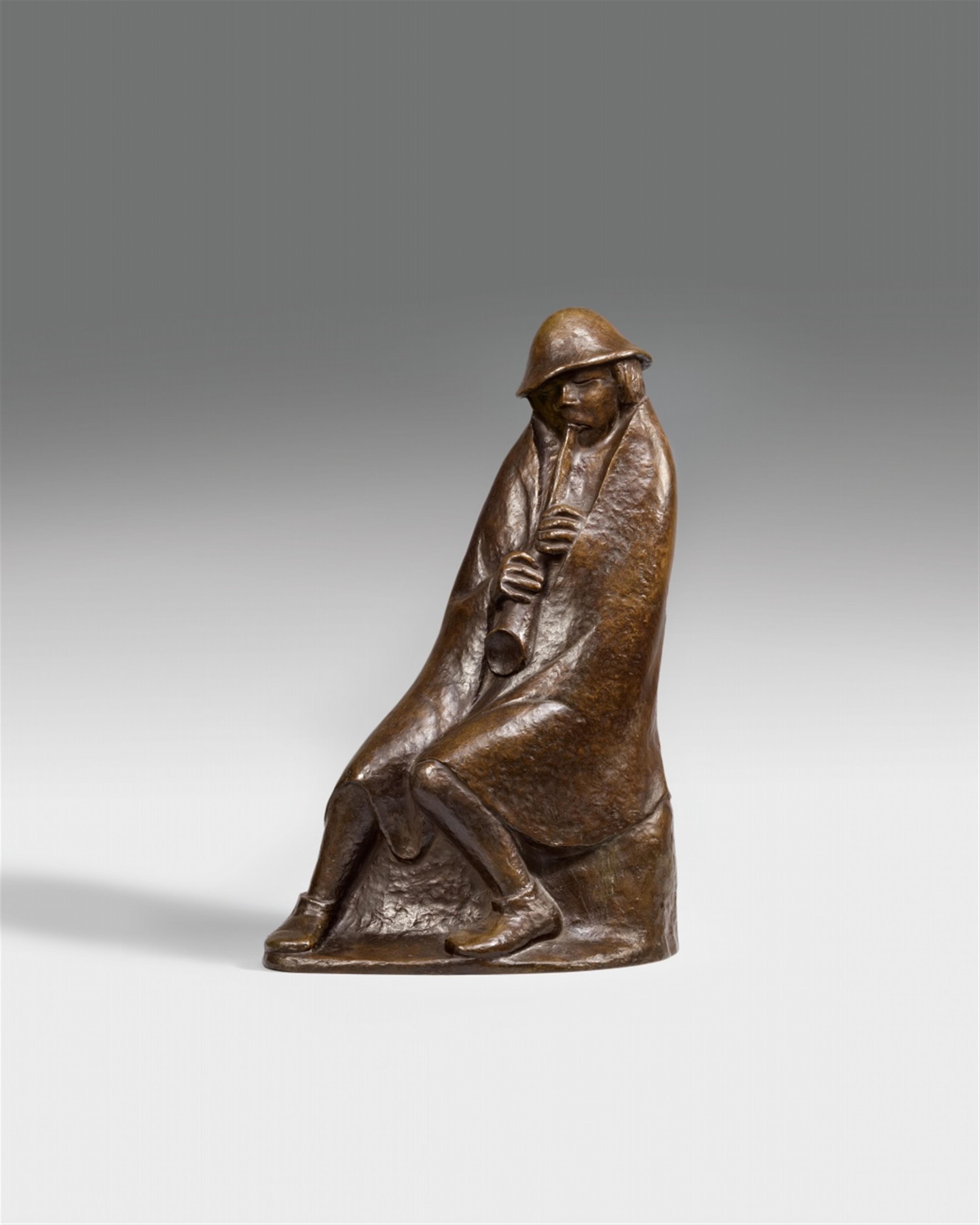Ernst Barlach
Der Flötenbläser
1936
Bronze Height 58.6 cm Signed 'E. Barlach' and with foundry mark "H. NOACK BERLIN" on the reverse at bottom. Posthumous cast. One of 29 bronze casts; 3 additional zinc casts are known to exist. - Fine golden-brown patina.
In 1936 two versions in wood as well as a working model in plaster (cf. Laur 595, 597 and 598) were created of this motif.
Music was an important source of inspiration for Ernst Barlach. “Der Flötenbläser” is a part of his artistic exploration of this theme and one of his last larger sculptural works altogether.
The sculpture is based on a charcoal drawing that the artist had already created in 1919/20 (Schult Zeichnungen 1366). According to Schult, a realisation in the form of a wooden sculpture had already been considered in 1921, at the request of the Wroclaw art collector Leo Lewin, but it was not carried out (cf. Schult, Plastiken 468). The fact that this cheerfully bucolic subject was taken up once again in 1936 can be interpreted as the artist's reaction against the oppressive living conditions that he had found himself in since 1933. During the final years of his life, he was artistically and privately heavily restricted by the repressive measures of the National Socialists.
The seated figure of the flute player leans to the left, resulting in the body's centre of gravity being shifted in an unusual way. The sculpture thus takes on the form of an acute triangle surging upwards. Through the cloak laid closely around the shoulders, the upper torso of the depicted figure is brought into a unified and closed form of the kind found so often in Barlach's sculptural work. The musician holds his instrument - a shawm - close to his chest, and a part of his face remains hidden beneath the hat pulled very far down. However, the lower legs visible beneath this cloak loosen up this block-like pose somewhat: the feet, which are spread far apart and positioned diagonally, and the knees falling towards one another provide the general pose of the figure with a spontaneous liveliness. The right leg projects out and thus forms an extension of the diagonal course of the right side of the body; the left leg is bent back in and keeps the body in balance through the foot pressed on the ground. These compositional means provide the flute player with a playful component and mitigate the impression of “earthly gravity” characteristic of Barlach's sculptures.
Catalogue Raisonné
Laur 596 2); Schult 469
Provenance
Dr. Osthoff, Bielefeld; Galerie Wilhelm Grosshennig, Dusseldorf, acquired there in 1963; since then private collection, North Rhine-Westfalia
Literature
Ernst Barlach. Die Briefe II, 1925-1938, Friedrich Droß (ed.), Munich 1969, no. 1327; Carl Dietrich Carls, Ernst Barlach. Das plastische, graphische und dichterische Werk, 5th ed., Flensburg/Hamburg 1950, p. 129; Ernst Barlach. Werke und Werkentwürfe aus fünf Jahrzehnten, revised by Elmar Jansen, Vol. 3, Berlin 1981, no. 88; Kunsthalle Mannheim, Bestandkatalog Skulptur - Plastik - Objekt, Mannheim 1982, p. 71, p. 440; Skulpturen. Bestandskatalog Wilhelm Lehmbruck Museum Duisburg, Christoph Brockhaus and Gottlieb Leinz (ed.), Duisburg 1992, p. 170; Anita Beloubek-Hammer, Ernst Barlach. Plastische Meisterwerke, Leipzig 1996, p. 150f.; Ernst Barlach und die Elemente, exhib. cat. Ernst Barlach Stiftung, Güstrow 2000, p. 70: Volker Probst, Wolke Däubler über Güstrow, in: Ernst Barlach und die Elemente, exhib. cat. Ernst Barlach Stiftung, Güstrow 2000, p. 56; Elisabeth Laur, Der Bildhauer als Buchkünstler, in: Ernst Barlach. Kaviar statt Brot. Kurt Reutti, Sammler und Stifter, exhib. cat. Kunsthalle Bremen, Bremen 2001, p. 29
Exhibitions
i.a.: Rostock 1945 (Städtisches Museum), Ernst Barlach; Schwerin 1947 (Landesmuseum), Ernst Barlach, cat. no. 83; Stockholm 1949 (Riksförbundet för bildande konst), Käthe Kollwitz och Ernst Barlach, cat. no. 76 ("Flöjtblasare") with illus. plate 8; Berlin 1951/52 (Deutsche Akademie der Künste), Ernst Barlach, cat. no. 75 with illus p. 161; Antwerpen 1957 (Middelheimpark), 4. Biennale voor Beeldhouwkunst, cat. no. 7 with illus. plate 1; Bremen 1959 (Kunsthalle), Ernst Barlach, cat. no. 503; Munich 2001 (Galerie Thomas), Ernst Barlach. Plastiken; Hamburg 2003 (Ernst Barlach Gesellschaft, Hauptkirche St. Katharinen Hamburg), Ernst Barlach. Mystiker der Moderne, p. 209

